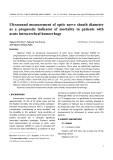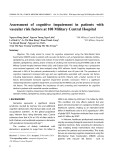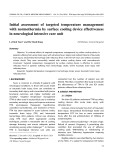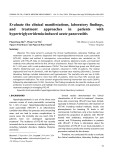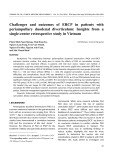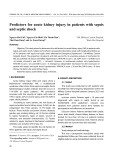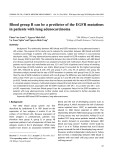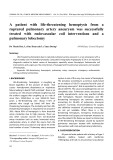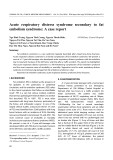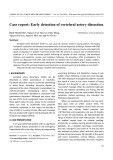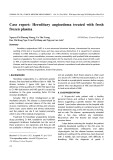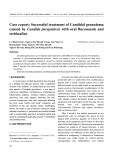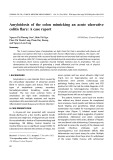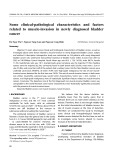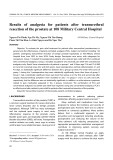doi:10.1046/j.1432-1033.2003.03794.x
Eur. J. Biochem. 270, 3859–3870 (2003) (cid:1) FEBS 2003
R E V I E W A R T I C L E
Investigating RNA polymerase II carboxyl-terminal domain (CTD) phosphorylation
Benoıˆt Palancade and Olivier Bensaude
Ge´ne´tique Mole´culaire, UMR 8541 CNRS, Ecole Normale Supe´rieure, Paris, France
The CTD phosphorylation pattern is precisely modified as RNAP II progresses along the genes and is involved in sequential recruitment of RNA processing factors. One of the most popular anti-phosphoCTD Igs, H5, has been proposed in several studies as a landmark of RNAP II molecules engaged in transcription. Finally, we discuss how global RNAP II phosphorylation changes are affected by the physiological context such as cell stress and embryonic development.
Keywords: RNA polymerase II; CTD-phosphorylation; CTD-kinase; CTD-phosphatase; transcription; mRNA processing.
Phosphorylation of RNA polymerase II’s largest subunit C-terminal domain (CTD) is a key event during mRNA including cell cycle- metabolism. Numerous enzymes, dependent kinases and TFIIF-dependent phosphatases tar- get the CTD. However, the repetitive nature of the CTD prevents determination of phosphorylated sites by conven- tional biochemistry methods. Fortunately, a panel of is available that distinguishes monoclonal antibodies between phosphorylated isoforms of RNA polymerase II’s (RNAP II) largest subunit. Here, we review how successful these tools have been in monitoring RNAP II phosphory- lation changes in vivo by immunofluorescence, chromatin immunoprecipitation and immunoblotting experiments.
subunits of the TFIIH general transcription factor, of the mediator complex and of the positive transcription elon- gation factor (P-TEFb), respectively.
Interactions with the unphosphorylated CTD are involved in assembly of RNAP II with the mediator complex to form a holoenzyme or with general transcrip- tion factors to form a preinititiation complex of tran- scription. Phosphorylation of the CTD is required to disrupt these interactions at elongation of transcription and to assist the recruitment of pre-mRNA modification enzymes [16,19].
The C-terminal domain (CTD) of RNA polymerase II’s (RNAP II) largest subunit is essential for transcription [1–3], for its function as enhancer [4,5], for organization of transcription foci within the nucleus [6] and for pre-mRNA processing [7,8]. The CTD consists of multiple repeats of a seven amino acid motif [9,10] (Fig. 1). This motif has been conserved during evolution in eukaryotes, but the number of repeats varies depending on the species: 26 in yeast, 45 in flies and 52 in mammals. Five out of seven amino acids in the consensus motif are phosphate acceptors and indeed phosphorylation is a major post-translational modification of the CTD in vivo [11]. Serine O-glycosylation has also been reported as a minor modification with unknown functional significance [12]. In contrast, CTD phosphory- lation plays a major role in the transcriptional process [13–16]. A large variety of kinases have been reported to phosphorylate the CTD of RNAP II in vitro [17,18]. Of particular significance, CDK7, CDK8 and CDK9 are
target
Initial studies generally considered CTD phosphoryla- tion as an all or nothing process. Here, we review recent evidence that multiple forms of CTD-phosphorylated RNAP II are present in cells. These forms have been characterized using monoclonal antibodies that distinguish between phosphorylated amino acid residues within the CTD. The phosphorylation site specificity of kinases and phosphatases that the CTD is discussed next. Variations in RNAP II phosphorylation are examined along the transcriptional process and as a function of physiological context including cell stress and early development.
Multiple RNAP II phosphoisoforms
Two distinct fractions of RNAP II were purified from mammalian cells in early studies and designated RNAP IIA and RNAP IIO [20]. They differ in the phosphorylation status of their largest subunit (Rpb1), respectively, designa- ted as IIa and IIo forms [13]. The CTD is hypophospho- rylated in the IIa form and multiphosphorylated in the IIo form. It is noteworthy that some preparations of RNAP II contain a third fraction, RNAP IIB, which results from an
Correspondence to O. Bensaude, Ge´ ne´ tique Mole´ culaire, UMR 8541 CNRS, Ecole Normale Supe´ rieure, 46 rue d’Ulm, 75230 Paris Cedex 05, France. Fax: + 33 1 44323941, Tel.: + 33 1 44323410, E-mail: bensaude@biologie.ens.fr Abbreviations: CDK, cyclin-dependent kinase; CTD, C-terminal domain (of Rpb1); DSIF, DRB sensitivity inducing factor; HIV-LTR, long-terminal repeats of the human immunodeficiency virus; FCP1, TFIIF-dependent CTD phosphatase; NELF, negative elongation factor; MAPK, mitogen-activated protein kinase; Rpb1, largest sub- unit of RNAP II; RNAP II, RNA polymerase II; SCP, small CTD phosphatase; TFIIx, x type general class II gene transcription factor. (Received 12 June 2003, revised 13 August 2003, accepted 15 August 2003)
3860 B. Palancade and O. Bensaude (Eur. J. Biochem. 270)
(cid:1) FEBS 2003
in vitro proteolysis of the CTD thus generating the IIb form of Rpb1.
Fig. 1. Sequence of the human CTD. Self- alignment of human RNAP II largest subunit sequence from amino acids 1593–1970 (last residue before the stop codon) (GeneBank accession number NM_000937). Note that serine at position 7 in the heptad motif is not conserved in the C-terminal section of the CTD. Serines 2 and 5, the major phosphoryl- ated residues are in red. Non-conserved amino acid residues are in blue.
Table 1. Phosphorylation dependence of anti-CTD monoclonal anti- bodies. Characterization of CTD phosphoepitopes: (1) using a set of yeast CTD fusion proteins mutated or not [31]; (2) using a set of synthetic peptides phosphorylated or not ([34]; A. Albert, S. Lavoie and M. Vincent, personal communication); (3) using purified RNAP II phosphorylated or not by MAP kinase [27].
The CTD is phosphorylated mainly on serine residues, although phosphothreonine and phosphotyrosine have been detected to a minor extent [21,22]. CTD phosphory- in electrophoretic lation provokes a remarkable shift migration equivalent to an apparent molecular weight increase from 210 to 240 kDa in vertebrates [23]. The number of phosphates in the mammalian IIo form has been evaluated as close to 50 residues, corresponding to one phosphate per repeat on average [24].
Name Epitope Method Reference
Limitations in epitope data interpretation
Phosphorylated forms that migrate between the IIa and IIo forms have also been described. An IIi (intermediary) form develops during Herpes simplex virus infection [25,26]. An IIm (MAP kinase-dependent) form is gener- ated during serum-stimulation of quiescent cells or during osmotic and oxidative stress [27,28]. An IIe (embryonic) form is found in nontranscribing early embryos from vertebrates [28,29] and insects [30]. Hence SDS/PAGE analysis unravels the diversity in phosphorylated forms of RNAP II.
Phosphorylation-dependent epitopes within the CTD
The specificity of monoclonal antibodies should be handled cautiously. For instance, depending on investigators, the 8WG16 antibody binds to the unphosphorylated CTD exclusively, or to both phosphorylated and unphosphory- lated CTD indistinctly [31–33]. In addition, although ELISA assays confirmed that H5 and H14 antibodies distinguished peptides phosphorylated on serines 2 or 5 at low antigen concentration, this specificity was lost at high antigen concentrations [34]. Moreover, a weaker binding with peptides phosphorylated simultaneously on serines 2 and 5 suggests that phosphorylation of adjacent sites might impair recognition. Furthermore, little is known about the consequences of amino acid substitution occurring at nonphosphorylated positions on degenerated repeats as found in the C-terminal half of the mammalian CTD. Finally, some of these antibodies such as H5, CC3 and MPM2 have been shown to cross-react with proteins other than the RNAP II largest subunit [35–37].
Due to the elevated number of phosphate acceptors and to the repetition of the consensus motif, it is a formidable task to determine precisely which serine residues are phosphory- lated in a particular repeat. Recently, a set of monoclonal antibodies became a powerful tool to investigate phos- phorylated residues within the CTD (Table 1). These antibodies have been characterized by Western blot using yeast CTD fusion proteins in which serines at positions 2 or 5 in all 26 heptads had been replaced either by alanine or by glutamate [31]. Some of these antibodies react preferentially with the unphosphorylated CTD whereas recognition by others requires phosphorylated serines at specific positions. It is worth mentioning that monoclonal antibodies H5 and H14 are often referred to as specific for phosphoserines 2 and 5, respectively.
8WG16 V15 V6 MARA3 B3 H14 H5 CC3 MPM2 Unphosphorylated Ser2 Unphosphorylated Unphosphorylated Ser2 Ser2-P or Ser5-P Ser2-P or Ser5-P Ser5-P Ser2-P Ser2-P Ser2-P and Ser5-P (1) (3) (3) (1) (1) (2) (1) (2) (1) (2) (1) (2) (2) [123] [27] [27] [31] [124] [110] [110] [125] [37]
RNA polymerase II CTD phosphorylation (Eur. J. Biochem. 270) 3861
(cid:1) FEBS 2003
(Table 3 and references therein); most studies concern the TFIIF-dependent CTD phosphatase (FCP1) [59]. Recently, three small FCP1 related proteins, SCP1/NLI-IF, SCP2/ OS4 and SCP3/HYA22, have been identified as also being CTD phosphatases [60]. In addition, the contribution of type 1 protein phosphatase (PP1) has been discussed in two reports [61,62] and the SSU72 transcription/processing factor has been hypothesized as a phosphotyrosine CTD phosphatase [63,64].
Despite these restrictions in establishing a correspondence between serine 2 or serine 5 phosphorylation and H5 or H14 recognition, these antibodies provide useful tools with which to characterize the phosphorylation of the CTD. As will be seen below, H5 and H14 reactivities unravel variations in the phosphorylation sites and may reflect differential action of CTD-kinases and CTD-phosphatases. Moreover, H5 reactivity might be used as a marker for transcribing RNAP II molecules.
Amino acid residues targeted by CTD-kinases invitro
In contrast to CTD-kinases that accept a wide range of substrates, the substrate specificity of FCP1 phosphatase is strictly restricted to the CTD within RNA polymerase II core enzyme [59]. The site preference of CTD phosphatases was determined using various RNAP IIO isozymes: FCP1 dephosphorylates RNAP IIO purified from mammalian cells [65] or RNAP IIO generated in vitro by phosphoryla- tion of RNAP IIA with purified kinases such as CDK7, CDK9, CDK1 or MAPK [66]. Consistently, FCP1 phos- phatase removes both H5 and H14 phosphoepitopes from mammalian RNAP IIO [66]. Therefore, in higher eukary- otes, phosphates on serine 2 (H5) and serine 5 (H14) appear equally removed by FCP1 phosphatase. In contrast, it has been proposed that fission yeast FCP1 specifically target serine 2 [34]. However, the Schizosaccharomyces pombe FCP1 assays were performed using peptides and highly acidic nonphysiological conditions. Saccharomyces cerevis- iae experiments involving FCP1 inactivation followed by chromatin immunoprecipitation (see below) suggested the occurrence of a distinct serine 5-specific phosphatase [34]. Interestingly, in contrast to FCP1, the small FCP1-related CTD phosphatase, SCP1, might preferentially dephos- phorylate phosphoserine 5 as CDK7-phosphorylated RNAP IIO is its preferred substrate [60].
Changes in RNAP II phosphorylation along gene transcription
CTD-kinases belong to three subclasses: cyclin-dependent kinases, mitogen-activated protein kinases and others (see Table 2 and [15,17,18]). Two methods have been used to determine phosphorylation site preference for a given CTD- kinase. The first method uses synthetic peptides consisting in one or more CTD heptads with the phosphorylable serine, threonine or tyrosine replaced by alanine [38,39]. Serine 5 phosphorylation is preferred for CDK7 [39–41], CDK8 [42,43], CDK9 [38] and MAPK [39]. Kinases such as CDK1 and CDK2 phosphorylate both serine 2 and serine 5 [41,44]. Efficiencies of the different kinases are influenced by the position of the targeted repeats within the CTD [38,45] and by the neighboring residue’s identity [38,39,43]. Slightly different conclusions were reached when deter- mining phosphoepitopes that were generated on purified RNAP II. For example, CDK7 (TFIIH) generates H14 epitope (serine 5) as predicted [46,47] but also the H5 one [48] and the CC3 one [45], which are specific for phosphoserine 2 [31]. Furthermore, CDK8 generates both H14 and H5 reactivity upon long phosphorylation times [46]. In discrepancy with peptide-driven conclusions, CDK9 generates H5 reactivity [47,49,50]. One might consider that genuine RNAP II CTD is a complex array of degenerated repeats differing from the peptides used in biochemical studies.
Transcription factors influence phosphorylation site preference
CTD kinases phosphorylate RNAP II within large supramolecular complexes that may influence the phos- phorylation reaction course. Recruitment of CDK7 in a DNA-bound transcription preinitiation complex increases its efficiency towards RNAP II CTD [51] and TFIIE enforces its preference for serine 5 [48].
Initial studies established that RNAP II is hypophosphory- lated when recruited to a promoter and then hyperphos- phorylated during messenger RNA synthesis [67–70]. Serine 5 phosphorylation by the mediator complex subunit Srb10 (CDK8 ortholog) precludes this recruitment [42]. An elegant study using step by step in vitro transcription in mammalian nuclear extracts has indicated that serine 5 (H14) is phosphorylated first in the initiation complex (likely by CDK7) and that serine 2 (H5) is phosphorylated by CDK9 upon entry into elongation [49]. When engaged in transcription elongation complexes, RNAP II becomes a poor substrate for FCP1, suggesting that conformational changes or protecting factors affect the efficiency of the phosphatase [71,72]. In support of the latter hypothesis, proteins that bind the phosphorylated CTD inhibit FCP1 activity (B. Palancade, N. F. Marshall, O. Bensaude, M. Dahmus & M.-F. Dubois, unpublished observation).
Transcriptional regulators contribute to recruit CTD kinases. Activation of HIV-LTR transcription by the viral transactivator Tat provides a paradigm of such a phenom- enon [52,53]. In the presence of Tat, CDK9 phosphorylates serine 5 (H14) in addition to serine 2 (H5) [50]. Several cellular activators also recruit CDK9 to enhance gene- specific transcription [54–57]. In contrast, the glucocorticoid receptor bound to its hormone represses nuclear factor- kappa B activation and this effect correlates with a decreased phosphorylation of serine 2 (H5) on target genes [58].
Amino acid residues targeted by CTD-phosphatases
Cellular DNA can be cross-linked to proteins in its vicinity and then immunoprecipitated with antibodies directed against these proteins. The presence of specific DNA sequences in the immunoprecipitated material is probed by polymerase chain reaction (PCR) amplification. Such chromatin immunoprecipitation (CHIP) assays have helped to map the evolution of CTD phosphorylation along a transcribed gene. Antibodies directed to the hypo- and the
In contrast to the large number of characterized CTD- few CTD-phosphatases have been identified kinases,
3862 B. Palancade and O. Bensaude (Eur. J. Biochem. 270)
(cid:1) FEBS 2003
.
,
] 0 5 1 [
- s o h p
E I I F T
,
] 2 5 1 [
s r o t c a f
P B T
] 8 3 1 [
1 r u B d n a 1 k t C
e l c y c
l a r e v e s
] 9 2 1 [
l l e c
y l l a i t n e r e f e r p
4 l a G
, ] 6 5 1 [
. c i l a t i
] 3 5 1 [
] 4 4 1 [
n
i
i
D T C e h t n o d e t a r e n e g
s t n e n o p m o c
] 1 3 1 [
, ] 7 3 1 [
n o i t p i r c s n a r t
9 K D C
] 8 2 1 [
a R A R
,
, e s a n k - 3 I P
, s n i e t o r p
s r o t a l u g e r
D o y M
] 7 0 1 [
,
s n i e t o r p
] 3 3 1 [
2 K D C
2 n s M
s e t a r t s b u s
l
n u j - c
, ] 2 3 1 [
] 2 4 1 , 6 3 [
H n
n i t a m o r h c
e l c y c
h g u o h t l
, ] 3 4 1 [
A
r a e l c u n
s r o t a l u g e r
F I I F T
3 5 p
b R
5 t p S
l a r u t c u r t S
, 1 K D C
l l e C
K P - A N D
, 4 n c G
r e h t O
D N
D N
, s o f - c
, 3 5 p
i l c y C
, *
s e p o t i p e o h p s o h p m o r f
. ] 6 2 1 [
(cid:2)
e r a s e u g o o h t r o e a i s i v e r e c
r o
.
f o
n o i t a g n o l e
t n e m
?
1 - V I H
1 - V I H
n o i t a i t i n
?
n o i t p i r c s n a r t
i
n o i t p i r c s n a r t
f o
f o
e v i s s e c o r p
t i u r c e r
e r t a u q - a` - e g a n e´ m
n
s i s o t i
(cid:1)
i
s e m y z n e
,
, s e d i t p e p c i t e h t n y s
o t n
i
S d n a s i s e h t n e r a p n
i
i
.
, 1 Q A M
l
l
n o i t p i r c s n a r t
m g n i r u d
g n p p a c
n o i t p i r c s n a r t
n o i t c n u F
t n e d n e p e d - t a T
y r t n E
n o i t a i t i n I
n o i s s e r p e R
t n e d n e p e d - t a T
?
? n o i t a g n o E
? n o i t a g n o E
?
?
n o i s s e r p e R
n w o n k n u
] 7 2 [
, ?
;
] 9 3 [
i
] 1 4 1 , 0 4 1 , 9 3 1
] 0 3 1
; (cid:2) s i o r t - a` - e g a n e´ m
(cid:1)
] 7 2 1 , 1 4 [
, 0 5 , 9 4 , 8 3 [
] 4 4 [
, 8 4 – 6 4 , 1 4 – 9 3 [
] 1 2 [
] 6 3 1 – 4 3 1
] 7 4 1 – 5 4 1 [
] 8 4 1 [
] 9 4 1 , 9 3 [
] 1 5 1 [
, 6 4 , 3 4 , 2 4 [
e c n e r e f e R
f o n o i t a l y r o h p s o h p o r t i v
e r a s e r u t a l c n e m o n r e h t o
n i
d e n m r e t e d
, 1 T A M
t o n
,
) ?
D N
) ?
) ?
l
; r o t p e c e r
4 1 H
5 H
5 H
4 1 H
5 H
(
(
D N
(
4 1 H
D N
4 1 H
5 H
4 1 H
5 H
. o v i v
4 1 H
s e p o t i p e o h p s o h P
D N
, s r e t c a r a h c d o b n
i
n i
d i c a
e c n e r e f e r p
1
5
5
5
7
5
* 5
2
2
5
2
d n a
r e S
r y T
e t i S
D N
r e S
r e S
r e S
D N
r e S
r e S
r e S
s e d i t p e P
r e S
r e S
r e S
d e t a c i d n
c i o n i t e r
i
o r t i v
,
n i
I -
r o H
a R A R
K D T C
x e l p m o C
b F E T - P
I I F T
K A C
r o t a i d e M
F P M
K P - A N D
) e p o t i p e
m o r f d e c u d e d n e e b e v a h s e c n e r e f e r p e t i S
i
5 H
; e s a n k
(
2
I
) 1 M X E H
(
s r e n t r a p
. s t r a p r e t n u o c
A N R n s
e r a s e m a n n i e t o r p n a i l a m m a m
g n i t a v i t c a - K D C
6 8 u K
1 Q A M
1 T A M
? 3 b f T
r e h t O
3 k t C
0 7 u K
K S 7
e n i r e s o h p s o h p
,
9 K D C
K
l a u s U
K A C
t s a e y
r o t c a f
, 2 T
B
s e t a r e n e g
,
i
t i
. s e r u t a e f
; r o t c a f
n
H n
E n
C n
A n
, 1 T n
i
s e s a n k
d e t a i c o s s
i l c y C
A
i l c y C
1 l c C
2 k t C
i l c y C
i l c y C
1 1 b r S
i l c y C
2 r u B
i l c y C
, s e d i t p e p
)
i
n i e t o r p
n o
s e s a n k
5
e n i r e s
) 5 1 O M
) 2 c d c (
E R L A T I P (
(
r i e h t d n a s e s a n i k - D T C
) 1 v g S (
g n i t o m o r p - n o i t a r u t a m
. 2
t n e d n e p e d - n
,
l
1 K D C
1 r u B
1 k t C
2 – 1 K R E
1 k p M
K P - A N D
2 K D C
8 K D C
0 1 b r S
9 K D C
7 K D C
8 2 n i K
d e t a v i t c a - n e g o t i
i
i l c y C
b a - c
s e t a l y r o h p
e s a n K
M
s r e h t O
e l b a T
g n d d u b s a d e s o p o r p n e e b h t o b e v a h
F P M
RNA polymerase II CTD phosphorylation (Eur. J. Biochem. 270) 3863
(cid:1) FEBS 2003
Table 3. The CTD-phosphatases and their features. The site preference has been determined by CTD-phosphatase assays in vitro. Previous nomenclature of SCPs is given in parenthesis. NLI-IF, nuclear LIM interactor–interacting factor; OS4, osteosarcoma gene 4; HYA22, human orthologue of S. pombe YA22 locus; ND, not determined; ?, unknown.
Phosphatase Regulatory protein Site preference References Function in transcription Other substrates
TFIIF-dependent phosphatases FCP1 RAP74 (TFIIF) Ser 2 (H5) [59,66] ?
TFIIB Ser 5 (H14)
SCP1 (NLI-IF) RAP74 (TFIIF) Ser 5 [60] ? Recycling of RNAP II after termination Regulation of elongation RNAP II mobilization CTD dephosphorylation after initiation? SCP2 (OS4) RAP74 (TFIIF) ND [60,154] ? ? Developmentally regulated transcription? SCP3 (HYA22) ? ND [60] ? ?
only capped mRNAs would be transcribed efficiently. The phosphorylated CTD next recruits SR proteins involved in splicing [83–85] followed by the cleavage-polyadenylation factors [86]. The serine 2-kinase Ctk1 is required for 3¢-end processing in S. cerevisiae [87]. Consistently, the Pcf11p cleavage-polyadenylation factor preferentially associates to the CTD phosphorylated on serine 2 rather than serine 5 [88]. Hence, transcription-dependent changes in CTD phosphorylation sites might be required to coordinate sequential recruitment of the processing machinery.
hyperphosphorylated CTD of Drosophila RNAP II dem- onstrated that RNAP II molecules pause at the 5¢ ends of heat shock genes in an unphosphorylated state [73]. In mammalian cells, phosphoserine 5 (H14) is concentrated near the promoter while serine 2 phosphorylation (H5) is observed throughout the gene [74]. In yeast, serine 5 is phosphorylated at initiation in a CDK7/Kin28-dependent manner [75,76]. The Ctk1-dependent serine 2 (H5) phos- phorylation develops next at the beginning of elongation and decrease in immunoprecipitation suggested that ser- ine 5 was dephosphorylated at this stage [34,76]. Alternat- ively, the latter finding might be interpreted as a loss of phosphoserine 5 recognition when both serines 2 and 5 are phosphorylated.
Taken together,
In addition to phosphorylation, degeneracy of the CTD adds a further level of complexity (Fig. 1). Indeed, the N-terminal half of the CTD only stimulates capping whereas the C-terminal half supports capping as well as splicing and 3¢-end processing [89,90]. Different repeats in the CTD may serve distinct functions.
Changes in CTD phosphorylation determine the recruitment of chromatin modification enzymes
the chromatin immunoprecipitation experiments demonstrate that distinct residues are phos- phorylated on the CTD during the progression of RNAP II along the genes in vivo (Fig. 2). Interestingly, an alanine scanning analysis of the CTD in yeast RNAP II had suggested that phosphorylation on both serine 2 and serine 5 position in the repeats was required for viability but a search for suppressor mutations indicated that these positions differed functionally [77,78].
Changes in CTD phosphorylation facilitate pre-mRNA processing
Recently, CTD phosphorylation has been shown to be involved in histone methylation control in budding yeast. Indeed, phosphorylation of RNAP II mediates the recruit- ment of histone H3 methyltransferases from the SET family [79,91]. Serine 5-phosphorylated RNAP II contributes to the association of the Set1/COMPASS methyltransferase complex onto the 5¢-portion of actively transcribed genes shortly after initiation, thereby enhancing histone H3 K4 trimethylation and providing a molecular mark of recent transcriptional activity [92,93]. Subsequently, the Set2 histone H3 K39 methyltransferase is recruited to the elongation complex through direct binding to the CTD phosphorylated by Ctk1 on serines at position 2 [94,95]. Thus, distinct phosphorylated RNAP II isoforms contri- bute to chromatin imprinting.
Specific CTD phosphorylation patterns therefore deter- mine and coordinate the interactions with protein partners such as transcription factors, histone-modifying complexes or mRNA-processing enzymes.
The CTD mediates the coupling between transcription and pre-mRNA processing. The phosphorylated CTD recruits the pre-mRNA processing machinery [79]. Serine 5 phos- phorylation of the CTD by CDK7/Kin28 is sufficient to recruit and stimulate capping enzymes upon initiation [75,76,80]. The capping enzyme may in turn, assist the recruitment of CDK9 as in S. pombe, the CDK9 ortholog binds Pct1, a subunit of the capping apparatus [81]. Consistently, inactivation of capping enzyme in Caenorhab- ditis elegans results in a loss of serine 2 (H5) phosphoryla- tion [82]. Capping might be a prerequisite to elongate transcription and contribute to a transcriptional checkpoint:
PP1 Phosphoserine/phosphothreonine protein phospshatases (PPP) At least seven different regulatory subunits Ser 2 (H5) Ser 5 (H14) [62] [155] Tat-dependent HIV-1 transcription? Transcription factors, splicing factors, cell cycle regulators [155]
3864 B. Palancade and O. Bensaude (Eur. J. Biochem. 270)
(cid:1) FEBS 2003
Global changes in RNAP II phosphorylation
leads to an increase in the amount of phosphorylated RNAP II [32].
The IIa and IIo RNAP II phosphoisoforms coexist in a dynamic equilibrium in yeast [33], insect [96], amphibian [28] and mammalian cells [97]. Importantly, this dynamic exchange does not require transcription as it is also observed in a nontranscribing cell system such as the amphibian egg [98]. Addition of purified phosphorylated RNAP IIO to a crude egg extract demonstrated a half turnover of CTD phosphates of 2–4 min. In this system, the antagonistic action of FCP1 and of ERK type MAP kinase accounts for the distribution between phosphorylated and unphosphory- lated RNAP II forms [98,99].
cells,
In transcribing
the CTD phosphorylation dynamic is unraveled upon CTD kinase/phosphatase inactivation. In S. cerevisiae, inactivation of either Kin28 (the CDK7 orthologue) or Ccl1, its cyclin partner, results in a rapid decrease in the amount of CTD-phosphoryl- ated RNAP II [33,100]. Conversely, Fcp1 inactivation
Selective gene inactivation in mammalian cells is less straightforward but, fortunately, numerous chemical inhi- bitors are available instead. Kinase inhibitors have generally limited specificity but this problem might be circumvented by using a panel of compounds belonging to distinct chemical families and by comparing efficiencies in vitro and in vivo. This procedure has been used to suggest that CDK9 is the major CTD kinase generating the bulk IIo form in interphasic mammalian cells [36,97,101]. RNAP II hyper- phosphorylation increases following treatments such as exposure to a-amanitin [102] or actinomycin D [101], or upon UV irradiation [103]. As this increase is suppressed by CDK9 inhibitors [101], it is suggested to result from an enhanced activity of CDK9 provoked by the transcriptional arrest [104,105]. Similarly, Ctk1 is required for serine 2 phosphorylation during the diauxic shift or following DNA damage in S. cerevisiae [106].
Fig. 2. CTD phosphorylation and the transcription cycle. (A) Recycling. The (cid:1)free(cid:2) RNAP II core enzyme is not phosphorylated on the CTD. It may assemble with coactivators such as the mediator complex (Med) thus forming a holoenzyme. Premature CTD phosphorylation by CDK8 prevents the assembly of RNAP II on the promotor. (B) Preinitiation. The unphosphorylated RNAP II core or holoenzyme assemble onto the promoter sequences with general transcription factors such as TFIID, TFIIA, TFIIB, TFIIE, TFIIF and TFIIH thus forming a preinititiation complex of transcription. The CTD is phosphorylated on serines at position 5 (5P) by the CDK7 subunit of TFIIH. (C) Initiation. Transcription begins. The phosphorylated CTD recruits the capping enzymes and the nascent transcript is capped at its 5¢ end. (D) Elongation. Phosphorylation of the CTD on serines at position 2 (2P) by the CDK9 subunit of the positive transcription elongation factor (P-TEFb) is required to remove to block opposed by the DSIF/NELF factors and elongate transcription. (E) RNA processing and transcription termination. The phosphorylated CTD recruits the splicing machinery to remove introns and, finally recruits the cleavage and polyadenylation factors that cleave the transcript and add a polyadenylic tail at its 3¢ end. This step signals transcription to terminate and RNAP II falls off its DNA template. The resulting mRNA is then exported to the cytoplasm. (F) To be recycled for another transcription round, RNAP II is dephosphorylated by the FCP1 CTD phosphatase.
RNA polymerase II CTD phosphorylation (Eur. J. Biochem. 270) 3865
(cid:1) FEBS 2003
However,
inactivation. Similar data are available for vertebrate embryos. H5-reactive RNAP II is absent from zebrafish embryos inactivated for TBP [121], and both H5 and H14 staining are attenuated in mouse embryos following inac- tivation of MAT1, the CDK7 partner [122]. These findings are consistent with an H14 staining attributed in part to initiating polymerases (productive or abortive) and an H5 staining of elongating polymerases.
Conclusion
the effect of kinase inhibition on CTD phosphorylation may be indirect. For instance, CDK8 phosphorylates cyclin H thereby inactivating CDK7 [107]. In turn, TFIIH inhibits the autophosphorylation of CDK9, which enhances its kinase activity [47]. Therefore, a body of arguments is required to strengthen the interpretation. For instance, the identification of ERK1/2 MAP kinase as the major CTD kinase generating the IIm forms relies on several arguments [27,98,99]: (a) the appearance of the IIm form correlates with MAP kinase activation; (b) it is insensitive to CDK9 inhibitors but suppressed in the presence of inhibitors of MAP kinase activation; (c) the immunogenicity of the IIm form matches that of RNAP II phosphorylated in vitro by MAP kinase.
Serine 2 phosphorylation (H5) as a landmark of transcribing RNAP II
Determining the sites phosphorylated in vivo within RNAP II CTD is a formidable task due to the repetitive nature of this domain. However, phosphospecific antibodies such as H5 and H14 have been successfully used in a wide range of experiments (Table 1). Using these tools, qualita- tive changes in the CTD phosphorylation pattern have been found to occur during the course of transcription or in response to physiological stimuli. These changes might contribute to synchronize the successive steps of nuclear mRNA metabolism (Fig. 2).
Many data point out that recognition of the CTD by the H5 antibody might be specific for RNAP II molecules is expected that an engaged in mRNA synthesis. It expanded use of other anti-CTD antibodies will contribute to improve our knowledge of CTD phosphorylation. Deciphering this (cid:1)CTD code(cid:2) may help our global under- standing of gene expression mechanisms [58].
Acknowledgements
Immunofluorescence analysis of polytene chromosomes revealed that hyperphosphorylated RNAP II is associated with actively transcribed sequences such as Drosophila ecdysone-induced puffs [108]. Interestingly, this study also suggested that transcribing RNAP II is less phosphorylated under heat-shock conditions. Although the H14 monoclonal antibody stains diffusely nuclei of interphasic mammalian cells, H5 reveals punctuated nuclear structures that match transcription foci [109]. During mitosis, at metaphase, both H14 and H5 epitopes are excluded from chromatin [110]. However, H14 staining is diffuse whereas H5 decorates mitotic granules (MIGs) which are speckle-like structures containing pre-mRNA processing material [111]. At telo- phase, H14 immunostaining develops in daughter nuclei simultaneously with recruitment of the general transcription machinery. Nuclear H5 staining develops at early G1 phase, in coincidence with the onset of transcription.
We are much indebted to Keith Blackwell and Marie-Franc¸ oise Dubois for critical reading of the manuscript. We thank Michae¨ l E. Dahmus, Michel Vincent and members of their lab for sharing unpublished information. This work was supported by grants from the Association pour la Recherche sur le Cancer (ARC 6250), the Ligue Nationale Contre le Cancer (Comite´ de Paris) and the Agence Nationale de Recherche sur le SIDA.
References
1. Corden, J.L. (1993) RNA polymerase II transcription cycles. Curr. Opin. Genet. Dev. 3, 213–218.
In many metazoans, early embryonic development following fertilization is characterized by global repression of zygotic transcription. Gene expression is initiated abruptly at the so-called mid-blastula transition (MBT) in amphibians, or zygotic genome activation (ZGA) in mam- mals. This period is marked by important CTD phosphory- lation changes that have been documented in nematodes, flies [30,112], fishes [113], amphibians [28] and mammals [29]. Before ZGA or MBT, the RNAP II CTD does not react with H5, which is consistent with the absence of transcription at this period. H5 reactivity has therefore been proposed as a landmark of zygotic gene activation in early embryos [28].
2. Meininghaus, M., Chapman, R.D. & Eick, D. (2000) Conditional expression of RNA polylmerase II in mammalian cells. Deletion of the carboxy-terminal domain of the large subunit affects early steps in transcription. J. Biol. Chem. 275, 24375–24382.
3. Meisels, E., Gileadis, O. & Corden, J.L. (1995) Partial truncation of the yeast RNA polymerase II carboxy-terminal domain pre- ferentially reduces expression of glycolytic genes. J. Biol. Chem. 270, 31255–31261.
4. Scafe, C., Chao, D., Lopes, J., Hirsch, J.P., Henry, S. & Young, R.A. (1990) RNA polymerase II C-terminal repeat influences response to transcriptional enhancer signals. Nature 347, 491– 494.
5. Gerber, H.P., Hagmann, M., Seipel, K., Georgiev, O., West, M.A.L., Litingung, Y., Schaffner, W. & Corden, J.L. (1995) RNA polymerase II C-terminal domain required for enhancer- driven transcription. Nature 374, 660–662.
In nematode embryos, a mixed diffuse/punctuated H14 staining develops in nuclei of somatic cells throughout embryogenesis whereas transcription-inactive germline cells show only two discrete foci [112]. In contrast, H5 staining appears in conjunction with ZGA at the four-cell stage and remains restricted to the transcriptionally active somatic cells, except for mutants that disrupt the asymmetric divisions of germline cells [114]. In contrast to H14, the H5 phosphoepitope is absent in embryos when transcription is globally impaired following RNA interference inactiva- tion of essential components of the transcription machinery such as CDK9 [115] or TBP-like factor (TLF) [116,117]. Both H14 and H5 staining are decreased upon CDK7 [118], RGR-1 mediator subunit [119], TFIIB or TAFIIs [120]
6. Misteli, T. (2000) Cell biology of transcription and pre-mRNA splicing: nuclear architecture meets nuclear function. J. Cell Sci. 113, 1841–1849. 7. Proudfoot, N.J., Furger, A. & Dye, M.J. (2002) Integrating mRNA processing with transcription. Cell 108, 501–512.
3866 B. Palancade and O. Bensaude (Eur. J. Biochem. 270)
(cid:1) FEBS 2003
polymerase II carboxy-terminal domain (CTD) recquiring ERK kinase activity. Nucleic Acids Res. 27, 4399–4404. 8. Howe, K.J. (2002) RNA polymerase II conducts a symphony of pre-mRNA processing activities. Biochim. Biophys. Acta 1577, 308–324. 9. Corden, J.L. (1990) Tails of RNA polymerase II. Trends Bio- 28. Palancade, B., Bellier, S., Almouzni, G. & Bensaude, O. (2001) Incomplete RNA polymerase II phosphorylation in Xenopus laevis early embryos. J. Cell Sci. 114, 2483–2489. chem. Sci. 15, 383–387.
10. Corden, J.L. & Ingles, C.J. (1992) Carboxy-terminal domain of the largest subunit of RNA polymerase II. In Transcriptional Regulation (McKnight, S.L. & Yamamoto, K.R., eds), pp. 81– 128, Cold Spring Harbor Laboratory Press, Cold Spring Harbor, NY. 29. Bellier, S., Chastant, S., Adenot, P., Vincent, M., Renard, J.-P. & Bensaude, O. (1997) Nuclear translocation and carboxyl-terminal domain phosphorylation of RNA polymerase II delineate the two phases of zygotic gene activation in mammalian embryos. EMBO J. 16, 6250–6262.
11. Bensaude, O., Bonnet, F., Casse´ , C., Dubois, M.-F., Nguyen, V.-T. & Palancade, B. (1999) Regulated phosphorylation of the RNA polymerase II C-terminal domain (CTD). Biochem. Cell Biol. 77, 1–7.
30. Leclerc, V., Raisin, S. & Leopold, P. (2000) Dominant-negative mutants reveal a role for the Cdk7 kinase at the mid-blastula transition in Drosophila embryos. EMBO J. 19, 1567–1575. 31. Patturajan, M., Schulte, R.J., Sefton, B.M., Berezney, R., Vin- cent, M., Bensaude, O., Warren, S.L. & Corden, J.L. (1998) Growth-related changes in phosphorylation of yeast RNA polymerase II. J. Biol. Chem. 273, 4689–4694. 12. Kelly, W.G., Dahmus, M.E. & Hart, G.W. (1993) RNA poly- merase II is a glycoprotein: modification of the COOH-terminal domain by O-GlcNAc. J.Biol. Chem. 268, 10416–10424.
13. Dahmus, M.E. (1996) Reversible phosphorylation of the C-ter- minal domain of RNA polymerase II. J. Biol. Chem. 271, 19009– 19012. 14. Riedl, T. & Egly, J.M. (2000) Phosphorylation in transcription: the CTD and more. Gene Expr. 9, 3–13. 32. Kobor, M.S., Archambault, J., Lester, W., Holstege, F.C., Gileadi, O., Jansma, D.B., Jennings, E.G., Kouyoumdjian, F., Davidson, A.R., Young, R.A. & Greenblatt, J. (1999) An unusual eukaryotic protein phosphatase required for transcrip- tion by RNA polymerase II and CTD dephosphorylation in S. cerevisiae. Mol. Cell. 4, 55–62.
15. Oelgeschlager, T. (2002) Regulation of RNA polymerase II activity by CTD phosphorylation and cell cycle control. J. Cell Physiol. 190, 160–169.
33. Valay, J.-G., Simon, M., Dubois, M.-F., Bensaude, O., Facca, C. & Faye, G. (1995) The KIN28 gene is required both for RNA polymerase II mediated transcription and phosphorylation of the Rpb1p CTD. J. Mol. Biol. 249, 535–544. 16. Kobor, M.S. & Greenblatt, J. (2002) Regulation of transcription elongation by phosphorylation. Biochim. Biophys. Acta 1577, 261–275.
34. Cho, E.J., Kobor, M.S., Kim, M., Greenblatt, J. & Buratowski, S. (2001) Opposing effects of Ctk1 kinase and Fcp1 phosphatase at Ser2 of the RNA polymerase II C-terminal domain. Genes Dev. 15, 3319–3329. 17. Majello, B. & Napolitano, G. (2001) Control of RNA poly- merase II activity by dedicated CTD kinases and phosphatases. Front. Biosci. 6, D1358–D1368.
18. Prelich, G. (2002) RNA polymerase II carboxy-terminal domain kinases: emerging clues to their function. Eukaryot. Cell. 1, 153– 162. 35. Doyle, O., Corden, J.L., Murphy, C. & Gall, J.G. (2002) The distribution of RNA polymerase II largest subunit (RPB1) in the Xenopus germinal vesicle. J. Struct. Biol. 140, 154–166.
19. Bentley, D. (2002) The mRNA assembly line: transcription and processing machines in the same factory. Curr. Opin. Cell Biol. 14, 336–342. 36. Lavoie, S.B., Albert, A.L., Handa, H., Vincent, M. & Bensaude, O. (2001) The peptidyl-prolyl isomerase Pin1 interacts with hSpt5 phosphorylated by Cdk9. J. Mol. Biol. 312, 675–685.
20. Schwartz, L.B. & Roeder, R.G. (1975) Purification and subunit structure of deoxyribonucleic acid-dependent ribonucleic acid polymerase II from the mouse plasmacytoma, MOPC 315. J. Biol. Chem. 250, 3221–3228. 37. Albert, A., Lavoie, S. & Vincent, M. (1999) A hyperphos- phorylated form of RNA polymerase II is the major interphase antigen of the phosphoprotein antibody MPM-2 and interacts isomerase Pin1. J. Cell Sci. 112, with the peptidyl-prolyl 2493–2500.
21. Baskaran, R., Dahmus, M.E. & Wang, J.Y.J. (1993) Tyrosine phosphorylation of mammalian RNA polymerase II carboxyl- terminal domain. Proc. Natl Acad. Sci. USA 90, 11167–11171.
38. Ramanathan, Y., Rajpara, S.M., Reza, S.M., Lees, E., Shuman, S., Mathews, M.B. & Pe’ery, T. (2001) Three RNA polymerase II carboxyl-terminal domain kinases display distinct substrate preferences. J. Biol. Chem. 276, 10913–10920. 22. Zhang, J. & Corden, J.L. (1991) Identification of phosphoryla- tion sites in the repetitive CTD of the mouse RNA polymerase II largest subunit. J. Biol. Chem. 266, 2290–2296.
39. Trigon, S., Serizawa, H., Conaway, J.W., Conaway, R.C., Jackson, S.P. & Morange, M. (1998) Characterization of the residues phosphorylated in vitro by different C-terminal domain kinases. J. Biol. Chem. 273, 6769–6775. 23. Dahmus, M.E. & Kedinger, C. (1983) Transcription of adeno- virus-2 major late promoter inhibited by monoclonal antibody directed against RNA polymerases II0 and IIA. J. Biol. Chem. 258, 2303–2307.
40. Roy, R., Adamczewski, J.P., Seroz, T., Vermeulen, W., Tassan, J.-P., Schaeffer, L., Nigg, E.A., Hoeijmakers, J.H.J. & Egly, J.-M. (1994) The MO15 cell cycle kinase is associated with the TFIIH transcription-DNA repair factor. Cell 79, 1093–1101. 24. Payne, J.M. & Dahmus, M.E. (1993) Partial purification and characterization of two distinct protein kinases that differentially phosphorylate the carboxy-terminal domain of RNA polymerase subunit IIa. J. Biol. Chem. 268, 80–87.
41. Gebara, M.M., Sayre, M.H. & Corden, J.L. (1997) Phosphory- lation of the carboxy-terminal repeat domain in RNA poly- merase II by cyclin-dependent kinases is sufficient to inhibit transcription. J. Cell Biochem. 64, 390–402. 25. Jenkins, H.L. & Spencer, C.A. (2001) RNA polymerase II holoenzyme modifications accompany transcription reprogram- ming in herpes simplex virus type 1-infected cells. J. Virol. 75, 9872–9884.
42. Hengartner, C.J., Myer, V.E., Liao, S.M., Wilson, C.J., Koh, S.S. & Young, R.A. (1998) Temporal regulation of RNA polymerase II by Srb10 and Kin28 cyclin-dependent kinases. Mol. Cell. 2, 43–53. 26. Rice, S.A., Long, M.C., Lam, V. & Spencer, C.A. (1994) RNA polymerase II is aberrantly phosphorylated and localized to viral replication compartments following Herpes Simplex virus infec- tion. J. Virol. 68, 988–1001.
27. Bonnet, F., Vigneron, M., Bensaude, O. & Dubois, M.-F. (1999) the RNA Transcription-independent phosphorylation of 43. Rickert, P., Corden, J.L. & Lees, E. (1999) Cyclin C/CDK8 and cyclin H/CDK7/p36 are biochemically distinct CTD kinases. Oncogene 18, 1093–1102.
RNA polymerase II CTD phosphorylation (Eur. J. Biochem. 270) 3867
(cid:1) FEBS 2003
transcript elongation. Prog. Nucleic Acid Res. Mol. Biol. 72, 333–365.
44. Deng, L., Ammosova, T., Pumfery, A., Kashanchi, F. & Nekhai, S. (2002) HIV)1 Tat interaction with RNA polymerase II CTD and a dynamic association with CDK2 induce CTD phos- phorylation and transcription from HIV-1 promoter. J. Biol. Chem. 277, 33922–33929. 60. Yeo, M., Lin, P.S., Dahmus, M.E. & Gill, G.N. (2003) A novel RNA polymerase II C-terminal domain phosphatase that pre- ferentially dephosphorylates serine 5. J. Biol. Chem. 278, 26078–26085.
61. Bharucha, D.C., Zhou, M., Nekhai, S., Brady, J.N., Shukla, R.R. & Kumar, A. (2002) A protein phosphatase from human T cells augments tat transactivation of the human immunodeficiency virus type 1 long-terminal repeat. Virology 296, 6–16.
45. Dubois, M.-F., Vincent, M., Adamczewski, J., Egly, J.M. & Bensaude, O. (1997) Heat shock inactivation of the TFIIH- associated kinase and change in the phosphorylation sites on RNA polymerase II largest subunit. Nucleic Acids Res. 25, 694–700. 46. Sun, X., Zhang, Y., Cho, H., Rickert, P., Lees, E., Lane, W. & Reinberg, D. (1998) NAT, a human complex containing Srb polypeptides that functions as a negative regulator of activated transcription. Mol. Cell. 2, 213–222. 62. Washington, K., Ammosova, T., Beullens, M., Jerebtsova, M., Kumar, A., Bollen, M. & Nekhai, S. (2002) Protein phosphatase- 1 dephosphorylates the C-terminal domain of RNA polymerase- II. J. Biol. Chem. 15, 15.
47. Zhou, M., Nekhai, S., Bharucha, D.C., Kumar, A., Ge, H., Price, D.H., Egly, J.M. & Brady, J.N. (2001) TFIIH inhibits CDK9 phosphorylation during human immunodeficiency virus type 1 transcription. J. Biol. Chem. 276, 44633–44640. 63. Ganem, C., Devaux, F., Torchet, C., Jacq, C., Quevillon- Cheruel, S., Labesse, G., Facca, C. & Faye, G. (2003) Ssu72 is a phosphatase essential for transcription termination of snoRNAs and specific mRNAs in yeast. EMBO J. 22, 1–11.
64. Meinhart, A., Silberzahn, T. & Cramer, P. (2003) The mRNA transcription/processing factor Ssu72 is a potential tyrosine phosphatase. J. Biol. Chem. 18, 15917–15921.
65. Cho, H., Kim, T.K., Mancebo, H., Lane, W.S., Flores, O. & Reinberg, D. (1999) A protein phosphatase functions to recycle RNA polymerase II. Genes Dev. 13, 1540–1552.
48. Yamamoto, S., Watanabe, Y., van der Spek, P.J., Watanabe, T., Fujimoto, H., Hanaoka, F. & Ohkuma, Y. (2001) Studies of nematode TFIIE function reveal a link between Ser-5 phos- phorylation of RNA polymerase II and the transition from transcription initiation to elongation. Mol. Cell Biol. 21, 1–15. 49. Kim, Y.K., Bourgeois, C.F., Isel, C., Churcher, M.J. & Karn, J. (2002) Phosphorylation of the RNA polymerase II carboxyl- terminal domain by CDK9 is directly responsible for human immunodeficiency virus type 1 Tat-activated transcriptional elongation. Mol. Cell Biol. 22, 4622–4637. 66. Lin, P.S., Dubois, M.-F. & Dahmus, M.E. (2002) TFIIF-asso- ciating carboxyl-terminal domain phosphatase dephosphorylates phosphoserines 2 and 5 of RNA polymerase II. J. Biol. Chem. 277, 45949–45956.
67. Cadena, D.L. & Dahmus, M.E. (1987) Messenger RNA synthesis in mammalian cells is catalyzed by the phosphorylated form of RNA polymerase II. J. Biol. Chem. 262, 12468–12474.
50. Zhou, M., Halanski, M.A., Radonovich, M.F., Kashanki, F., Peng, J., Price, D.H. & Brady, J.N. (2000) Tat modifies the activity of CDK9 to phosphorylate serine 5 of the RNA polymerase II carboxy-terminal domain during immuno- deficiency virus type 1 transcription. Mol. Cell Biol. 20, 5077–5086.
68. Payne, J.M., Laybourn, P.J. & Dahmus, M.E. (1989) The tran- sition of RNA polymerase II from initiation to elongation is associated with phosphorylation of the carboxyl-terminal domain of subunit IIa. J. Biol. Chem. 264, 19621–19629. 51. Rossignol, M., Kolb-Cheynel, I. & Egly, J.-M. (1997) Substrate specificity of the cdk-activating kinase (CAK) is altered upon association with TFIIH. EMBO J. 16, 1628–1637.
69. Lu, H., Flores, O., Weinmann, R. & Reinberg, D. (1991) The nonphosphorylated form of RNA polymerase II preferentially associates with the preinitiation complex. Proc. Natl Acad. Sci. USA 88, 10004–10008. 52. Mancebo, H.S., Lee, G., Flygare, J., Tomassini, J., Luu, P., Zhu, Y., Peng, J., Blau, C., Hazuda, D., Price, D. & Flores, O. (1997) P-TEFb kinase is required for HIV Tat transcriptional activation in vivo and in vitro. Genes Dev. 11, 2633–2644.
70. Chesnut, J.D., Stephens, J.H. & Dahmus, M.E. (1992) The interaction of RNA polymerase II with the adenovirus-2 major late promoter precluded by phosphorylation of the C-terminal domain of subunit IIa. J. Biol. Chem. 267, 10500–10506.
53. Cujec, T., Okamoto, H., Fujinaga, K., Meyer, J., Chamberlin, H., Morgan, D.O. & Peterlin, B.M. (1997) The HIV transacti- vator TAT binds to the CDK-activating kinase and activates the phosphorylation of the carboxy-terminal domain of RNA poly- merase II. Genes Dev. 11, 2645–2657. 71. Lehman, A.L. & Dahmus, M.E. (2000) The sensitivity of RNA polymerase II in elongation complexes to C-terminal domain phosphatase. J. Biol. Chem. 275, 14923–14932.
54. Kanazawa, S., Okamoto, T. & Peterlin, B.M. (2000) Tat com- petes with CIITA for the binding to P-TEFb and blocks the expression of MHC class II genes in HIV infection. Immunity 12, 61–70. 72. Marshall, N.F. & Dahmus, M.E. (2000) C-terminal domain phosphatase sensitivity of RNA polymerase II in early elongation complexes on the HIV-1 and adenovirus 2 major late templates. J. Biol. Chem. 275, 32430–32437.
73. O’Brien, T., Hardin, S., Greenleaf, A. & Lis, J.T. (1994) Phos- phorylation of RNA polymerase II C-terminal domain and transcriptional elongation. Nature 370, 75–77. 55. Lee, D.K., Duan, H.O. & Chang, C. (2001) Androgen receptor interacts with the positive elongation factor P-TEFb and enhances the efficiency of transcriptional elongation. J. Biol. Chem. 276, 9978–9984.
74. Cheng, C. & Sharp, P.A. (2003) RNA polymerase II accumula- tion in the promoter-proximal region of the dihydrofolate reductase and gamma-actin genes. Mol. Cell Biol. 23, 1961–1967. 75. Komarnitsky, P., Cho, E.J. & Buratowski, S. (2000) Different phosphorylated forms of RNA polymerase II and associated mRNA processing factors during transcription. Genes Dev. 14, 2452–2460. 56. Eberhardy, S.R. & Farnham, P.J. (2001) c-Myc mediates acti- vation of the cad promoter via a post-RNA polymerase II recruitment mechanism. J. Biol. Chem. 276, 48562–48571. 57. Barboric, M., Nissen, R.M., Kanazawa, S., Jabrane-Ferrat, N. & Peterlin, B.M. (2001) NF-kappaB binds P-TEFb to stimulate transcriptional elongation by RNA polymerase II. Mol. Cell. 8, 327–337.
76. Schroeder, S.C., Schwer, B., Shuman, S. & Bentley, D. (2000) Dynamic association of capping enzymes with transcribing RNA polymerase II. Genes Dev. 14, 2435–2440. 58. Nissen, R.M. & Yamamoto, K.R. (2000) The glucocorticoid receptor inhibits NFkB by interfering with serine-2 phosphory- lation of the RNA polymerase II carboxy-terminal domain. Genes Dev. 14, 2314–2329.
59. Lin, P.S., Marshall, N.F. & Dahmus, M.E. (2002) CTD phos- phatase: role in RNA polymerase II cycling and the regulation of 77. West, M.L. & Corden, J.L. (1995) Construction and analysis of yeast RNA polymerase II CTD deletion and substitution muta- tions. Genetics 140, 1223–1233.
3868 B. Palancade and O. Bensaude (Eur. J. Biochem. 270)
(cid:1) FEBS 2003
polymerase II CTD regulates H3 methylation in yeast. Genes Dev. 17, 654–663.
78. Yuryev, A. & Corden, J.L. (1996) Suppression analysis reveals a functional difference between the serines in positions two and five in the consensus sequence of the C-terminal domain of yeast RNA polymerase II. Genetics 143, 661–671.
96. Venetianer, A., Dubois, M.-F., Nguyen, V.T., Seo, S.J., Bellier, S. & Bensaude, O. (1995) Phosphorylation state of RNA poly- merase II C-terminal domain (CTD) in heat-shocked cells: pos- sible involvement of the stress activated MAP kinases. Eur. J. Biochem. 233, 83–92. 79. Carty, S.M. & Greenleaf, A.L. (2002) Hyperphosphorylated C-terminal repeat domain-associating proteins in the nuclear proteome link transcription to DNA/chromatin modification and RNA processing. Mol. Cell Proteomics 1, 598–610.
80. Ho, C.K. & Shuman, S. (1999) Distinct roles for CTD Ser-2 and Ser-5 phosphorylation in the recruitment and allosteric activation of mammalian capping enzyme. Mol. Cell 3, 405–411.
97. Dubois, M.F., Nguyen, V.T., Bellier, S. & Bensaude, O. (1994) Inhibitors of transcription such as 5,6-dichloro-1-b-D-ribofuran- osyl benzimidazole (DRB) and isoquinoline sulfonamide deri- vatives (H-8 and H-7*), promote the dephosphorylation of the C-terminal domain (CTD) of RNA polymerase II largest sub- unit. J. Biol. Chem. 269, 13331–13336.
81. Pei, Y., Schwer, B. & Shuman, S. (2003) Interactions between fission yeast Cdk9, its cyclin partner Pch1, and mRNA capping enzyme Pct1 suggest an elongation checkpoint for mRNA quality control. J. Biol. Chem. 278, 7180–7188.
98. Palancade, B., Dubois, M.F., Dahmus, M.E. & Bensaude, O. (2001) Transcription-independent RNA polymerase II dephos- phorylation by the FCP1 CTD-phosphatase in Xenopus laevis early embryos. Mol. Cell Biol. 21, 6359–6368.
82. Takagi, T., Walker, A.K., Sawa, C., Diehn, F., Takase, Y., Blackwell, T.K. & Buratowski, S. (2003) The Caenorhabditis elegans mRNA 5¢-capping enzyme: in vitro and in vivo charac- terization. J. Biol. Chem. 278, 14174–14184. 83. Greenleaf, A.L. (1993) A positive addition to a negative tail’s tale. Proc. Natl Acad. Sci. USA 90, 10896–10897. 99. Bellier, S., Dubois, M.-F., Nishida, E., Almouzni, G. & Ben- saude, O. (1997) Phosphorylation of RNA polymerase II largest subunit during Xenopus laevis oocyte maturation. Mol. Cell Biol. 17, 1434–1440.
84. Patturajan, M., Wei, X., Berezney, R. & Corden, J.L. (1998) A nuclear matrix protein interacts with the phosphorylated C-terminal domain of RNA polymerase II. Mol. Cell Biol. 18, 2406–2415.
85. Kim, E.L., Bregman, D.B. & Warren, S.L. (1997) Splicing factors associate with hyperphosphorylated RNA polymerase II in the absence of pre-mRNA. J. Cell Biol. 136, 19–28.
100. Valay, J.G., Dubois, M.-F., Bensaude, O. & Faye, G. (1996) Ccl1, a cyclin associated with protein kinase Kin28 controls the phosphorylation of RNA polymerase II largest subunit and mRNA transcription. C.R. Acad. Sci. Paris 319, 183–190. 101. Casse´ , C., Giannoni, F., Nguyen, V.T., Dubois, M.-F. & Ben- saude, O. (1999) The transcriptional inhibitors, actinomycin D and a-amanitin, activate the HIV-1 promoter and favor phos- phorylation of the RNA polymerase II C-terminal domain. J. Biol. Chem. 274, 16097–16106.
86. McCracken, S., Fong, N., Yankulov, K., Ballantyne, S., Pan, G., Greenblatt, J., Patterson, S.D., Wickens, M. & Bentley, D.L. (1997) The C-terminal domain of RNA polymerase II couples mRNA processing to transcription. Nature 385, 357–361.
102. Nguyen, V.T., Giannoni, F., Dubois, M.-F., Seo, S.-J., Vigneron, M., Ke´ dinger, C. & Bensaude, O. (1996) In vivo degradation of RNA polymerase II largest subunit triggered by a-amanitin. Nucleic Acids Res. 24, 2924–2929.
87. Skaar, D.A. & Greenleaf, A.L. (2002) The RNA polymerase II CTD kinase CTDK-I affects pre-mRNA-3¢ cleavage/polyade- nylation through the processing component Pti1p. Mol. Cell 10, 1429–1439.
103. Bregman, D.B., Halaban, R., Van Gool, A.J., Henning, K.A., Friedberg, E.C. & Warren, S.L. (1996) UV-induced ubiquitina- tion of RNA polymerase II: a novel modification deficient in Cockayne syndrome cells. Proc. Natl Acad. Sci. USA 93, 11586–11590. 88. Licatalosi, D.D., Geiger, G., Minet, M., Schroeder, S., Cilli, K., McNeil, J.B. & Bentley, D.L. (2002) Functional interactions of yeast pre-mRNA-3¢ end processing factors with RNA poly- merase II. Mol. Cell 9, 1101–1111.
104. Nguyen, V.T., Kiss, T., Michels, A.A. & Bensaude, O. (2001) 7SK small nuclear RNA binds to and inhibits the activity of CDK9/cyclin T complexes. Nature 414, 322–325.
89. Ryan, K., Murthy, K.G., Kaneko, S. & Manley, J.L. (2002) Requirements of the RNA polymerase II C-terminal domain for reconstituting pre-mRNA-3¢ cleavage. Mol. Cell Biol. 22, 1684– 1692. 105. Yang, Z., Zhu, Q., Luo, K. & Zhou, Q. (2001) The 7SK small nuclear RNA inhibits the CDK9/cyclin T1 kinase to control transcription. Nature 414, 317–322.
90. Fong, N. & Bentley, D.L. (2001) Capping, splicing, and 3¢ pro- cessing are independently stimulated by RNA polymerase II: different functions for different segments of the CTD. Genes Dev. 15, 1783–1795. 106. Ostapenko, D. & Solomon, M.J. (2003) Budding yeast CTDK-I is required for DNA damage-induced transcription. Eukaryot. Cell 2, 274–283.
91. Hampsey, M. & Reinberg, D. (2003) Tails of intrigue: phos- phorylation of RNA polymerase II mediates histone methylation. Cell 113, 429–432. 107. Akoulitchev, S., Chuikov, S. & Reinberg, D. (2000) TFIIH is negatively regulated by cdk8-containing mediator complexes. Nature 407, 102–106.
92. Ng, H.H., Robert, F., Young, R.A. & Struhl, K. (2003) Targeted recruitment of Set1 histone methylase by elongating Pol II pro- vides a localized mark and memory of recent transcriptional activity. Mol. Cell. 11, 709–719. 108. Weeks, J.R., Hardin, S.E., Shen, J., Lee, J.M. & Greenleaf, A. (1993) Locus-specific variation in phosphorylation state of RNA polymerase II in vivo: correlations with gene activity and tran- script processing. Genes Dev. 7, 2329–2344.
109. Zeng, C., Kim, E., Warren, S.L. & Berget, S.M. (1997) Dynamic relocation of transcription and splicing factors dependent upon transcriptional activity. EMBO J. 16, 1401–1412.
93. Krogan, N.J., Dover, J., Wod, A., Schneider, J., Heidt, J., Boateng, M.A., Dean, K., Ryan, O.W., Golshani, A., Johnston, M., Greenblatt, J.F. & Shilatifard, A. (2003) The Paf1 complex is required for histone H3 methylation by COMPASS and Dot1p: linking transcriptional elongation to histone methylation. Mol. Cell. 11, 721–729. 110. Bregman, D.B.L., van der Zee, S. & Warren, S.L. (1995) Tran- scription-dependent redistribution of the large subunit of RNA polymerase II to discrete nuclear domains. J. Cell Biol. 129, 287–298.
94. Li, J., Moazed, D. & Gygi, S.P. (2002) Association of the histone methyltransferase Set2 with RNA polymerase II plays a role in transcription elongation. J. Biol. Chem. 277, 49383–49388. 95. Xiao, T., Hall, H., Kizer, K.O., Shibata, Y., Hall, M.C., Borc- hers, C.H. & Strahl, B.D. (2003) Phosphorylation of RNA 111. Prasanth, K.V., Sacco-Bubulya, P.A., Prasanth, S.G. & Spec- tor, D.L. (2003) Sequential entry of components of gene expression machinery into daughter nuclei. Mol. Biol. Cell 14, 1043–1057.
RNA polymerase II CTD phosphorylation (Eur. J. Biochem. 270) 3869
(cid:1) FEBS 2003
129. Zhao, J., Dynlacht, B., Imai, T., Hori, T. & Harlow, E. (1998) Expression of NPAT, a novel substrate of cyclin E-CDK2, promotes S-phase entry. Genes Dev. 12, 456–461. 112. Seydoux, G. & Dunn, M.A. (1997) Transcriptionally-repressed germ cells lack a subpopulation of phosphorylated RNA poly- merase II in early embryos of C. elegans and D. melanogaster. Development 124, 2191–2201.
130. Svejstrup, J.Q., Vichi, P. & Egly, J.-M. (1996) The multiple roles of transcription/repair factor TFIIH. Trends Biochem. Sci. 21, 346–350.
113. Knaut, H., Pelegri, F.K.B., Schwarz, H. & Nusslein-Volhard, C. (2000) Zebrafish vasa RNA but not its protein is a component of the germ plasm and segregates asymmetrically before germline specification. J. Cell Biol. 149, 875–888. 131. Fisher, R.P. & Morgan, D.O. (1994) A novel cyclin associates with MO15/CDK7 to form the CDK-activating kinase. Cell 78, 713–724.
114. Tenenhaus, C., Schubert, C. & Seydoux, G. (1998) Genetic requirements for PIE-1 localization and inhibition of gene expression in the embryonic germ lineage of Caenorhabditis elegans. Dev. Biol. 200, 212–224. 132. Ko, L.J., Shieh, S.Y., Chen, X., Jayaraman, L., Tamai, K., Taya, Y., Prives, C. & Pan, Z.Q. (1997) p53 is phosphorylated by CDK7-cyclin H in a p36-MAT1 dependent manner. Mol. Cell Biol. 17, 7220–7229.
133. Ohkuma, Y. & Roeder, R.G. (1994) Regulation of TFIIH ATPase and kinase activities by TFIIE during active initiation complex formation. Nature 368, 160–163. 115. Shim, E.Y., Walker, A.K., Shi, Y. & Blackwell, T.K. (2002) CDK-9/cyclin T (P-TEFb) is required in two postinitiation pathways for transcription in the C. elegans embryo. Genes Dev. 16, 2135–2146.
134. Liao, S.-M., Zhang, J., Jeffery, D.A., Koleske, A.J., Thompson, C.M., Chao, D.M., Viljoen, M., van Vuuren, H.J.J. & Young, R.A. (1995) A kinase-cyclin pair in the RNA polymerase II holoenzyme. Nature 374, 193–196.
116. Dantonel, J.C., Quintin, S., Lakatos, L., Labouesse, M. & Tora, L. (2000) TBP-like factor is required for embryonic RNA poly- merase II transcription in C. elegans. Mol. Cell 6, 715–722. 117. Kaltenbach, L., Horner, M.A., Rothman, J.H., Mango, S.E. & Sharp, P.A. (2000) The TBP-like factor CeTLF is required to activate RNA polymerase II transcription during C. elegans embryogenesis. Mol. Cell 6, 705–713. 135. Leclerc, V., Tassan, J.P., O’Farrell, P.H., Nigg, E.A. & Le´ opold, P. (1996) Drosophila cdk8, a kinase partner of cyclin C that interacts with the large subunit of RNA polymerase II. Mol. Biol. Cell 7, 505–513.
136. Rickert, P., Seghezzi, W., Shanahan, F., Cho, H. & Lees, E. (1996) Cyclin C/CDK8 is a novel CTD kinase associated with RNA polymerase II. Oncogene 12, 2631–2640.
137. Chi, Y., Huddleston, M.J., Zhang, X., Young, R.A., Annan, R.S., Carr, S.A. & Deshaies, R.J. (2001) Negative regulation of Gcn4 and Msn2 transcription factors by Srb10 cyclin-dependent kinase. Genes Dev. 15, 1078–1092. 118. Wallenfang, M.R. & Seydoux, G. (2002) cdk-7 is required for mRNA transcription and cell cycle progression in Caenorhabditis elegans embryos. Proc. Natl Acad. Sci. USA 99, 5527–5532. 119. Shim, E.Y., Walker, A.K. & Blackwell, T.K. (2002) Broad requirement for the mediator subunit RGR-1 for transcription in the C. elegans embryo. J. Biol. Chem. 277, 30413–30416. 120. Walker, A.K., Rothman, J.H., Shi, Y. & Blackwell, T.K. (2001) Distinct requirements for C.elegans TAFIIs in early embryonic transcription. EMBO J. 20, 5269–5279.
138. Hirst, M., Kobor, M.S., Kuriakose, N., Greenblatt, J. & Sadowski, I. (1999) GAL4 is regulated by the RNA polymerase II holoenzyme-associated cyclin-dependent kinase SRB10/CDK8. Mol. Cell 3, 673–678.
139. Zhu, Y., Pe’ery, T., Peng, J., Ramanathan, Y., Marshall, N., Marshall, T., Amendt, B., Mathews, M.B. & Price, D.H. (1997) Transcription elongation factor P-TEFb is required for HIV-1 Tat transactivation in vitro. Genes Dev. 11, 2622–2632. 121. Muller, F., Lakatos, L., Dantonel, J., Strahle, U. & Tora, L. (2001) TBP is not universally required for zygotic RNA poly- merase II transcription in zebrafish. Curr. Biol. 11, 282–287. 122. Rossi, D.J., Londesborough, A., Korsisaari, N., Pihlak, A., Lehtonen, E., Henkemeyer, M. & Makela, T.P. (2001) Inability to enter S phase and defective RNA polymerase II CTD phosphorylation in mice lacking Mat1. EMBO J. 20, 2844– 2856.
140. Price, D.H. (2000) P-TEFb, a cyclin-dependent kinase controlling elongation by RNA polymerase II. Mol. Cell Biol. 20, 2629–2634. 141. Ramanathan, Y., Reza, S.M., Young, T.M., Mathews, M.B. & Pe’ery, T. (1999) Human and rodent transcription elongation factor P–TEFb: interactions with human immunodeficiency virus type 1 Tat and carboxy-terminal domain substrate. J. Virol. 73, 5448–5458. 123. Thompson, N.E., Steinberg, T.H., Aronson, D.B. & Burgess, R.R. (1989) Inhibition of in vivo and in vitro transcription by monoclonal antibodies prepared against wheat germ RNA polymerase II that react with the heptapeptide repeat of eukaryotic RNA polymerase II. J. Biol. Chem. 264, 11511– 11520.
142. Kim, J.B. & Sharp, P.A. (2001) Positive transcription elongation factor b phosphorylates hSPT5 and RNA polymerase II carboxy- terminal domain independently of cyclin-dependent kinase acti- vating kinase. J. Biol. Chem. 276, 12317–12323. 124. Mortillaro, M.J., Blencowe, B.J., Wei, X., Du Nakayasu, H.L., Warren, S.L., Sharp, P.A. & Berezney, R. (1996) A hyperphos- phorylated form of the large subunit of RNA polymerase II is associated with splicing complexes and the nuclear matrix. Proc. Natl Acad. Sci. USA 93, 8253–8257. 143. Simone, C., Bagella, L., Bellan, C. & Giordano, A. (2002) Phy- interaction between pRb and cdk9/cyclin T2 complex. sical Oncogene 21, 4158–4165.
125. Vincent, M., Lauriault, P., Dubois, M.-F., Lavoie, S., Bensaude, O. & Chabot, B. (1996) The nuclear matrix protein p255 is a highly phosphorylated form of RNA polymerase II largest sub- unit which associates with the spliceosome. Nucleic Acids Res. 24, 4649–4652. 144. Simone, C., Stiegler, P., Bagella, L., Pucci, B., Bellan, C., De Falco, G., De Luca, A., Guanti, G., Puri, P.L. & Giordano, A. (2002) Activation of MyoD-dependent transcription by CDK9/ cyclin T2. Oncogene 21, 4137–4148.
126. Michels, A.A., Nguyen, V.T., Fraldi, A., Labas, V., Edwards, M., Bonnet, F., Lania, L. & Bensaude, O. (2003) MAQ1 ((cid:1)me´ nage a` quatre(cid:2)) and 7SK RNA interact with CDK9/CyclinT complexes in a transcription-dependent manner. Mol. Cell Biol. 23, 4859–4869.
145. Lee, J.M. & Greenleaf, A.L. (1989) A protein kinase that phos- phorylates the C-terminal repeat domain of the largest subunit of RNA polymerase II. Proc. Natl Acad. Sci. USA 86, 3624–3628. 146. Sterner, D.E., Lee, J.M., Hardin, S.E. & Greenleaf, A.L. (1995) The yeast carboxyl-terminal repeat domain kinase CTDK-I is a divergent cyclin-cyclin-dependent kinase complex. Mol. Cell Biol. 15, 5716–5724. 127. Cisek, L.J. & Corden, J.L. (1989) Phosphorylation of RNA polymerase by the murine homologue of the cell-cycle control protein cdc2. Nature 339, 679–684. 128. Nigg, E.A. (1995) Cyclin-dependent protein kinases: key regula- 147. Patturajan, M., Conrad, N.K., Bregman, D.B. & Corden, J.L. (1999) Yeast carboxyl-terminal domain kinase I positively and tors of the eukaryotic cell cycle. Bioessays. 17, 471–480.
3870 B. Palancade and O. Bensaude (Eur. J. Biochem. 270)
(cid:1) FEBS 2003
associated protein kinase that phosphorylates RNA polymerase II. Proc. Natl Acad. Sci. USA 89, 11920–11924. 152. Smith, G.C. & Jackson, S.P. (1999) The DNA-dependent protein kinase. Genes Dev. 13, 916–934. 153. Van Etten, R.A. (1999) Cycling, stressed-out and nervous: cel- negatively regulates RNA polymerase II carboxyl-terminal domain phosphorylation. J. Biol. Chem. 274, 27823–27828. 148. Murray, S., Udupa, R., Yao, S., Hartzog, G. & Prelich, G. (2001) Phosphorylation of the RNA polymerase II carboxy-terminal domain by the Bur1 cyclin-dependent kinase. Mol. Cell Biol. 21, 4089–4096. lular functions of c-abl. Trends Cell Biol. 9, 179–186.
154. Zohn, I.E. & Brivanlou, A.H. (2001) Expression cloning of Xenopus Os4, an evolutionarily conserved gene, which induces mesoderm and dorsal axis. Dev. Biol. 239, 118–131. 155. Bollen, M. & Beullens, M. (2002) Signaling by protein phos- phatases in the nucleus. Trends Cell Biol. 12, 138–145. 149. Dubois, M.-F., Nguyen, V.T., Dahmus, M.E., Page` s, G., Pouysse´ gur, J. & Bensaude, O. (1994) Enhanced phosphorylation of the C-terminal domain of RNA polymerase II upon serum stimulation of quiescent cells: possible involvement of MAP kinases. EMBO J. 13, 4787–4797. 150. Treisman, R. (1996) Regulation of transcription by MAP kinase cascades. Curr. Opin. Cell Biol. 8, 205–215.
156. Keriel, A., Stary, A., Sarasin, A., Rochette-Egly, C. & Egly, J.M. (2002) XPD mutations prevent TFIH-dependent transactivation by nuclear receptors and phosphorylation of RARa. Cell 109, 125–135. 151. Dvir, A., Peterson, S.R., Knuth, M.W., Lu, H. & Dynan, W.S. (1992) Ku antigen is the regulatory component of a template-




